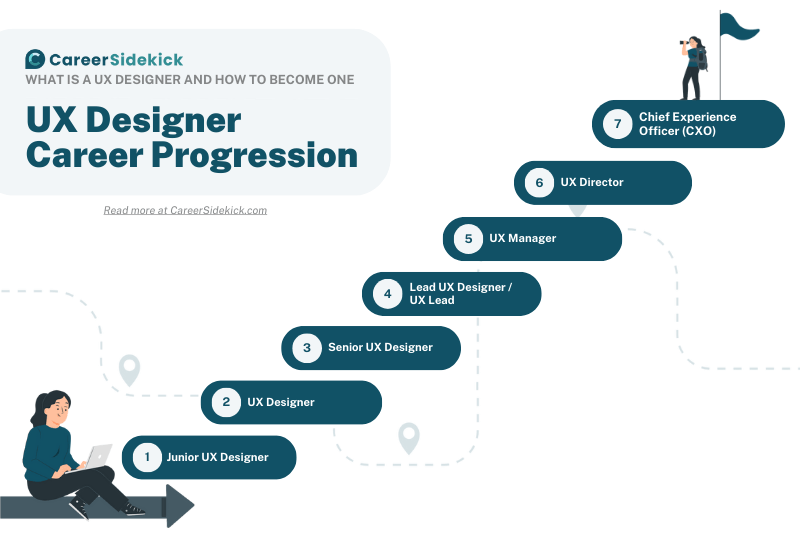
The world of UI/UX design is rapidly evolving, and with it, the career paths for designers have become more dynamic. Whether you’re just starting or looking to climb the ladder, understanding UI/UX career progression is crucial. But what do experienced professionals say about growth in this field?
In this article, we’ll explore the stages of a UI/UX designer’s career, the skills needed for advancement, and expert advice on how to stay ahead in this competitive industry.
Understanding UI/UX Career Progression
UI/UX design isn’t just about creating visually appealing interfaces—it’s about enhancing user experiences through research, design thinking, and interaction design. Career growth in this field depends on a mix of technical skills, strategic thinking, and problem-solving abilities.
Entry-Level: The Foundation of UI/UX Design
Starting a career in UI/UX design typically involves roles such as:
- Junior UX Designer
- UI Designer
- UX Researcher
At this stage, designers focus on:
- Learning design principles (typography, color theory, layout)
- Mastering tools like Figma, Sketch, and Adobe XD
- Conducting user research and usability testing
- Building a strong portfolio
Pro Tip: Get hands-on experience by working on real-world projects or internships.
Mid-Level: Expanding Responsibilities & Specialization
After gaining experience, designers transition to mid-level roles like:
- UX Designer
- UI/UX Developer
- Product Designer
Mid-level designers are expected to:
✔️ Take ownership of projects
✔️ Collaborate with developers and stakeholders
✔️ Improve usability through data-driven insights
✔️ Specialize in areas like accessibility, motion design, or UX strategy
Practitioner Insight: “Mid-level designers should focus on storytelling and business impact to stand out.” – Sarah M., Senior UX Designer
Senior-Level: Leadership & Strategic Thinking
At the senior level, UI/UX professionals become:
- Senior UX Designer
- Lead UX Researcher
- UX Strategist
Key responsibilities include:
- Leading UX strategy and decision-making
- Mentoring junior designers
- Driving business value through user-centered design
- Presenting ideas to executives
Expert Advice: “The best senior designers are those who think beyond pixels and contribute to business growth.” – James K., UX Lead
UI/UX Career Progression Beyond Senior Roles
Once designers reach senior positions, they can explore executive roles such as:
UX Manager or Director – Overseeing design teams and aligning UX with business goals
Chief Experience Officer (CXO) – Driving company-wide experience strategies
Freelancer or Consultant – Providing expert design solutions to various clients
Pro Insight: “Management isn’t the only path. Many designers thrive as independent consultants or specialists.” – Lena T., UX Consultant
Key Skills for UI/UX Career Growth
To advance in UI/UX design, practitioners emphasize the following skills:
- Technical Skills: Figma, prototyping, user research, front-end basics
- Soft Skills: Communication, collaboration, empathy, problem-solving
- Business Acumen: Understanding user needs and aligning them with business goals
- Continuous Learning: Keeping up with design trends, AI, and emerging technologies
How to Stay Ahead in UI/UX Design?
According to experienced practitioners, staying competitive in UI/UX requires:
- Networking: Engage with design communities, attend UX meetups
- Portfolio Updates: Showcase new projects, case studies, and impact-driven designs
- Certifications & Courses: Upskill through UX bootcamps, Google UX certifications
- Side Projects: Experiment with passion projects or open-source contributions
Frequently Asked Questions
What is the typical career path for a UI/UX designer?
A UI/UX career starts with junior roles, progresses to mid-level and senior positions, and may lead to executive leadership or consulting.
How long does it take to become a senior UX designer?
Typically, it takes 5-7 years of experience, along with leadership and strategic thinking skills, to reach a senior UX role.
Is coding necessary for UI/UX designers?
While UI/UX designers don’t need advanced coding skills, understanding front-end development (HTML, CSS, JavaScript) can be beneficial.
How can I switch to UI/UX from another career?
You can transition into UI/UX by learning design principles, taking online courses, building a portfolio, and networking with professionals.
What are the highest-paying UI/UX careers?
Senior UX designers, UX managers, UX strategists, and CXOs typically earn the highest salaries in the field.
How do I stay updated with UI/UX trends?
Follow design blogs, listen to UX podcasts, take advanced courses, and experiment with new tools
Conclusion
UI/UX design is a rewarding and evolving field, offering diverse career paths. From junior designers to CXOs, career progression depends on skill development, strategic thinking, and industry adaptation. By learning from experienced practitioners and staying ahead of trends, aspiring designers can carve out a successful career in UI/UX.